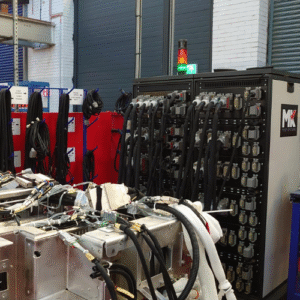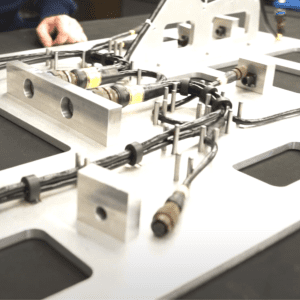Automeg Resources
Brochures, manuals and videos
Frequently Asked Questions
With high voltage testing (Insulation resistance and HiPot / dielectric testing), it is rarely the test system that defines the testing time. OEMs and specific industries tend to have their own test requirement specification that define:
- Ramp up time (time to charge the wire/harness/net from 0V to test voltage)
- Measurement Dwell (the time during which the high voltage is maintained and the system measures leakage current or insulation resistance)
Here’s an example – a harness with 10 nets needs testing at 1000Vdc. The test specification defines the ramp time as 0.5s (so 1s to ramp to 1000V), and the measurement dwell at 1s. The test time will therefore be at least 100(nets) x [1s (Ramp) + 1s (Measurement)] = 200 seconds. That time is defined purely by the test specification, not the test system.
When you require low voltage testing as well as HV, the low voltage test is nearly negligible compared to the high voltage segment. So, when planning for test time on a harness, the test specification for high voltage test should be your reference document.
If you would like further assistance in calculating accurate test timings, please get in touch. Just send us your test specification and harness/product details, and an application specialist can help.
- Prepare the logo. The logo image needs to be scaled to a suitable size – we recommend 180px wide by 110px high.
- Save the logo in jpeg image format; it must be named CustomerLogo.jpg
- Copy the logo to the following location on the PC hosting MKAT Runner: C:ProgramDataMK Test Systems LimitedReportsLogos. Note: You’ll need to replace the existing file of the same name in this folder.
- That’s it! From now on, all default reports will display your company logo in the top right position as shown below.

Yes, Automeg does have a simple self-test routine. We recommend performing system self-tests at regular intervals to ensure optimal performance of all critical components like switching relays, power supplies, measurement and stimulus circuits, etc.
The frequency of performing self-test depends on several factors such as how often the system is used and how many test points are in your system, among others. It is very common for users to perform self-test at regular intervals such as when the system is turned-on, at the beginning of each shift or prior to executing every job.
You can also set Automeg to run self-test automatically every time the system is switched on.
We have a full blog article answering this question here.
We have a full blog article answering this question here.
We have a full blog article answering this question here.
For insulation testing, the Automeg system is capable of producing 1500VDC on any test point (via the front panel connectors) hence the warning label. The operator should ensure the test has completed and the results shown on screen before touching any connectors or interface cables.
The portable Automeg requires the earth connection through the main lead for safe operation.





